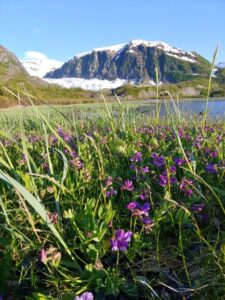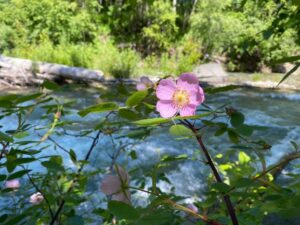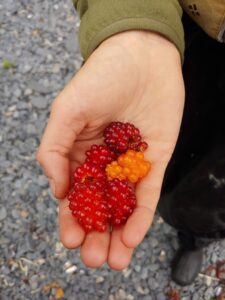Alaska Wild Berries and Flowers
When thinking of Alaska, often lush eco-systems and expansive terrain comes to mind. And you wouldn’t be wrong. There are dozens of integral eco-systems that span across this enormous state. These wildernesses are intricately woven with many layers of bio-diversity. More specifically, they are filled with Alaskan wildflowers and berries.
From the frozen tundra to the ocean sides, life is teeming around every turn. Nothing beats a day in the sunshine, eating fresh picked berries, and sauntering through vibrant and fragrant fields of summer blooms. Further, it is a great activity for all ages and abilities to be able to identify and spot native Alaskan wildflowers and berries.
❀Wild Flowers❀
Fireweed – Chamerion angustifolium
Fireweed is an Alaskan wildflower that you can find almost anywhere in the state. It’s primary growing season ranges from early summer to late fall. It is a perennial plant, returning with each

The start of fireweed blooms in Glacier View
years warm seasons. This plant is tall and vibrant with bright displays of fuchsia blooms that grow from the bottom of the stalk, upward.
This species becomes easily abundant and can blanket full meadows and hillsides in colonies. You can find these plants from sea level to sub alpine zones (USFS).
Fireweed is known to be some of the first species to colonize after large fires and disturbances to the soil. An important teammate for soil restoration throughout the region. They can grow so big that some have been recorded at towering 9 ft. tall!
Simultaneously, fireweed is an important plant to indigenous peoples for medicinal and material uses. Once the plant has bloomed the flowers go to seed with silky tufts in the fall. These are airborne seeds, spread far and wide by the wind. One single fireweed plant can produce up to 80,000 seeds. Additionally, they can cultivate through the rhizomes they leave in the soil. And, requires the help of fungal partners to grow.
Devil’s Club – Oplopanax horridus
⚠ CAUTION ⚠
To find this ominously named plant you will have to head to the well-drained forests on the coast of Alaska. Due to the cover of spines and stinging hairs on the stalk of this plant it is in your best interest to avoid direct contact. These spines and stingers cover the plant from stalk to leaves, leaving only the berries and roots without the threat of injury.
Additionally, this plant has been used for a variety of medicinal benefits by indigenous people across the world for hundreds of years. Just recently has western medicine recognized these benefits. Bears are a big fan of the berries and help their seeds travel all over Alaska by eating them and digesting them.
This plant then grows to help stabilize areas that have been disturbed. If you are hiking through areas with Devil’s Club be sure to protect yourself with thick pants and long sleeves! These plants typically grow in clumps.

Beach Peas in bloom along the coast of Blackstone Bay
Beach Pea – Lathyrus japonicus
The beach pea is typically found near the coastal regions of Alaska. You can also find them in the marsh and wetland areas. These pea-shaped flowers can spotted in hues of pinks and purples. The Denaʼina people have been known to eat their seeds either raw, boiled, or preserved in seal oil (Central Coast).
These Alaskan wildflowers bloom from June till August along beaches and dunes. These are easy to spot on kayaking trips through the bays and sounds of Alaska. Find them alongside sandy and rocky beaches as well as beyond the hightide lines amongst the driftwood. They will be sprawled out in a vine like fashion across the shore.
Wild Rose – Variety of Species Variance
In Alaska each region has a different adaptation of the wild rose. To the North, the Arctic rose (Rosa acicularis), in the coastal areas, there is the Nootka rose (Rosa nutkana), and to the South,

A wild rose grows next to a river in Southeast Alaska
the Sitka rose. Each comes from the same family, but is specialized to their specific region. Many people like to forage this plant, many parts of it are edible.
These Alaskan wildflowers have spiny stalks and flower in beautiful shades of pinks. In the fall they fruit. These dark red fruits are known as rosehips perfect for teas and syrups. These plants are typically low-lying shrubs found in meadows and woodlands. Additionally, the pink flowers have yellow stamens and come with a pleasant aroma, perfect for attracting pollinators. So go ahead, stop and smell the roses if you spot these bushes.

An alpine lupine starts to flower alongside a rugged mountain terrain
Lupine – Lupinus articus
Lupine grows primarily along the coastal regions in Alaska, along roadsides and filling meadows. You can spot them by their brilliant colors and defined leaf shapes. They come in hues of blues and purples that tower up the stalks of the plant.
These Alaskan wildflowers are native and essential to restoring nitrogen in soils. Wild Lupine is a flowering member of the legume family. The pea pods that contain their seeds are known to be toxic, and are not to be ingested.
The seeds contain a neurotoxin that they may have developed to deter herbivores from ingesting them.Their blooms reach to be about 3 ft. tall. This plant is characterized by its fuzzy stalk and leaves that have radiating symmetry and come with 5 to 9 leaflets.
Wild Berries
Alaska Blueberry – Vaccinium uliginosum
Alaska is often revered for it’s bountiful collection of edible wild berries. The Alaska blueberry is often at the top of that list for many berry pickers. The most abundant of the species is the Bog blueberry in Alaska. Beautiful pink flower bonnets bloom through the summer and have a delicate

A plump blueberry sits nestled alongside crowberry bushes.
sweet scent to them.
These blooms are even considered an Alaskan wildflower. Look close to the ground for these, they are a shrub like plant. As the fall rounds the corner you can find mountain sides and fields filled beyond your imagination with delicious berries.
Check out where to find the best blueberry picking spots here. They are an essential food source for many animals and are well loved and used by indigenous peoples. You can spot these small black and purple berries quite easily. (Alaska.gov)

Salmon berries come in a variety of colors
Salmon Berry – Rubus spectabilis
This fruiting plant is often found along the coastal regions and mountain sides of Alaska. Their fruits are quite similar to raspberries. However, they are much larger, less sweet (still delicious), and range in colors from deep maroons to sherbet oranges.
This wild berry can reach heights of 3 to 12 ft. and thrive beside red alder (USFS). These plants have woody stalks with fine prickles. However, they are not too much trouble when it comes to picking. You can enjoy collecting their berries during the summer months, dependent on the region, from early May to late July.
Cranberry – Vacinnium oxycoccus
These berry bushes thrive in Alaska. You can find them in wetlands and bog-like areas. The cranberry plant can grow in abundance as a close to the ground shrub, only becoming a couple feet tall. This bush can be found along the Southeastern regions and offers their fruit in the fall.
Cranberry flowers through the summer months and fruits into the fall as their leaves turn a deep red along with the berries. This plant grows into mats along the ground. They’re berries are tart and sweet, noted for their relationship in the food system and with indigenous cultures. They can be perfect for jams, syrups, and juices as well. (University of Maine)
Crowberry – Empetrum nigrum
The crowberry is a low and creeping plant that crawls across the ground in mats. They are spongy to the touch. Crowberry, for the most part, grows exclusively in arctic-like regions. These plants
flower in the summer and produce small, black berries in the fall.
Their leaves are needle like in shape, yet not too

Crowberry flowering in an alpine region
prickly to the touch. When flowering, you can enjoy views of their small purple to white blooms. Once fruited, you can spot the berry by its dark black to purple colors and shiny exterior.
Inside, the berry is juicy and sweet with a slight crunch of the small nut-like seeds inside. They almost remind you of eating a pomegranate seed. You can find this berry in the forest, in alpine regions, and even in the tundra. This plant has a prominent role as a medicine in indigenous cultures for benefits to the eyes and kidneys. (Arctic Berries)
Baneberry – Actaea rubra
⚠ CAUTION ⚠
The baneberry is a well known poisonous berry in Alaska. To be able to characterize this plant may be essential to your explorations. The plant has a poisonous essential oil in each part of the plant and can be extremely harmful if ingested. If ingested in large quantities, could have adverse effects to the nervous system.
Some symptoms include; irritation of the mouth and throat, nausea, stomach cramping, headache, dizziness, diarrhea, increased heart rate, etc. (Crane M.F. 1990). They can even be fatal to small children. These plants are characterized by small white cluster flowers.Additionally, the stamens of these blooms have a feathery appearance to them. The berries grow in spherical bundles at the end of the stalks in red and white colors.
The leaves are three-pronged with serrated edges and grow in a shrub like fashion. The white blooms of flowers occur in the summer, while the berries are present in the fall. These plants are essential to feeding small animals and creating ground cover for the forest.
The Offerings of Alaska
As you explore the wilderness and wildland areas of Alaska be sure to keep an eye out for these Alaskan wildflowers and berries and see if you can identify these plants. If you are looking to forage plants, flowers, and/or fruits be sure to keep in mind; Do not eat ANY wild plant unless you are 150% certain of its identification! This article is not a foraging guide. To explore more information on foraging and identification visit this Foraging Alaska Manual and utilize their contact resources for questions you may have.
When visiting wilderness areas practice Leave No Trace and be aware of your surroundings and local wildlife. We love berries and flowers and it is important to keep in mind that other animals do as well, especially bears. In summary, be aware of your surroundings, be a considerate guest to the areas you are visiting, and give space to wildlife. Further, enjoy the sights, smells, and tastes that wild Alaskan wildflowers and berries have to offer.

